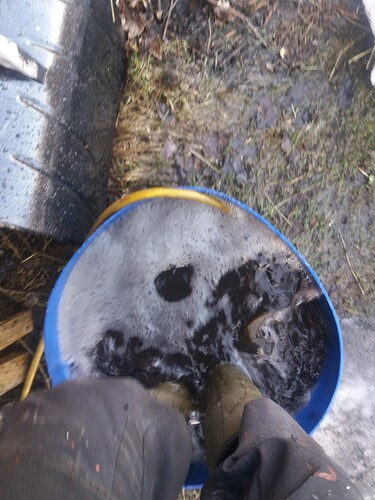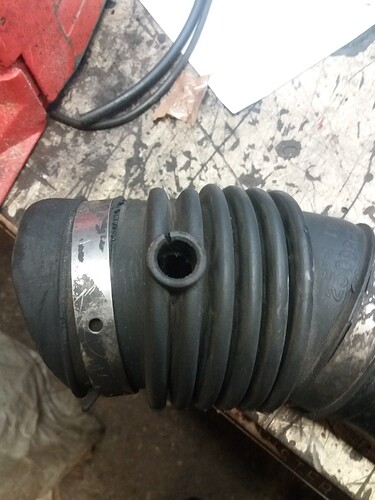Yes it does. Now you can see how helpful gauges are!
Thank you Don, yes but you should be able to afford to buy them too, these will be quite cheap if they now work for a while.
Jan, pulling 15" on the gasifier at 50-55 mph is pretty normal to me.
The “normal” hopper vacuum is different for every gasifier. Depends on how restrictive your air supply or nozzles are. Anything between 1/6 and 1/3 of the gasifier vacuum is ok for me. You will soon get the feeling of what’s normal to your system.
Service of the filter for the S10, it works quite well, except when I spray water in the boots instead of in the bucket.
When I see what the water looks like, I’m glad it’s not in the engine.
The newest grate looks like this, about 12-15mm (1/2"- 9/16") wide on the gap.
It seems that the gasifier gets clogged pretty quickly, do you have any advice to prevent it?
I have tried larger pieces of wood, without results.
That grate looks like it should work without clogging. Do you keep the rpm’s up without a lot of slow idling? Velocity of gas should keep it clean.
I have not ridden anything at idle, holding about 50-55 mph a little faster sometimes.
Hi Jan, is the grate reinforced on the bottom side to keep it from warping. Cross bracing will help it from looking like a potato chip. There is a lot of heat at the grate. Looking at the top of the grate the slots in your grate look good you should not have to worry about it pluging at the grate because of the grate not having large enough openings.
Bob
Wondering if it gets as hot in an Imbert as in a WK on the grate, I have restriction 4-5 "up from the grått, and the reduction of the gas in the charcoal should take down the heat, but think that the speed of the gas is also very less at the grate at Imbert than at WK.
The speed of the gas at the grate should be determined by the demand from the engine more than the design of the gasifier so I don’t think it would not be different with Imbert or WK. My 2 cents worth.
Ok, I thought the speed of the gas was due to how big the surface is where the gas goes out of the fire pipe, as I understand it has WK reduction in the bottom of the fire pipe just above the grate?
I also think there is a big difference in the speed of the gas in the new unit compared to the old one I have, where I had a problem with the coal coming with the gas, here it is across.
Hi Jan, it is the charcoal bed on how tight it is or loose it is in the firetube changes velocities of the air/gases. The tight charcoal bed causes restrictions and your vaccum will be higher then if it is loose charcoal bed with less restriction. The velocity of the gas is directly related to this. This true only if there is no other restriction some where else like in the filter causing a high vaccum, this is another good reason from having a vaccum gauge after the filter for comparisons. If the filter starts to plug up the vaccum will increase and at the charcoal bed it will not be able to purge itself clear, and the ash will start pluging things up there. Smaller pathways make for higher velocities and the gases move faster not slower.
Ask me how I know this, it is simple it has happen to me. When I was experimenting with different materials in my hay filter like using terry cloth or bath towel in the very top of the filter over my hay, it became wet and plugged up. I ended up with a plugged up charcoal bed at the grate with no power to go down the road.
The same thing would happen if you have to small of Nozzles opening for the size of the engine cubic displacement in the cylinders. With the imbert gasifer they have charts to follow for nozzles sizing. You already know this and others that build the Imbert gasifers.
Keeping your restriction opening large enough to make sure you do not make tar at idle and not making tar going down the road at highway speeds is important also.
It is a real balancing act when doing gasification operations in a vehicle.
Bob
Edit:
Yes to what Steve is saying in the comment above.
Bob
Hmm, now you have to teach me again, now I’m completely gone, must be something I miss.
Imbert gas emissions to the grate 12 "no preheating in the air.
WK gas emissions to the grate (has for me Wayne said 7.5 ")? Preheating on the air.
Hope you help me understand.
JanA, these systems designers use NO air pre-heating. In fact will even isolate the incoming air to keep it as cold and dense as possible:
Systems Williams; Manning; IISC and a few others. None of these do vehicles.
Maybe Abaddessa and PowerHearths slit throat’s fit in here too? No air pre-heating.
Then the Ultra air pre-heating W.K.'s. First engine exhaust pre-heating the gasifier inlet air. Then produced hot gasses more boost heating that already heated, to be inlet air. AND then; even more super heating that inlet air along the hearth walls. (this last actually to temperature re-distribute hearth tub temperature gradients)
Inlet air is then TOO hot to measure. Metals eroding at the hearth air inlet holes areas. Much of the later WK evolution was to handle this super boosted air.
And these MUST go slow internal velocities to keep erosions damaging minimized, and from melting down.
Then Imbert; Imbert-like variations with some moderate air preheating. The modern Finns systems. All of BenP’s works. All of GEK/APL’s works.
The latest put-up being Joni’s single zone systems fits in here. Moderate air pre-heating as is convenient. With just a finishing WK-like very shallow grate section. But NOT a WK grate spiller. A grate char saver.
Again.
It all depends on the intended actual used fuel woods.
The purposes the system will be put too.
The willingness of the fabricator to make it up. ~10 meters of weld lines in Joni’s. Must be 100 meters at least of weld lines in a true WK. Everybody else in between these extremes.
The willingness of the actual Operator to run his system. And this last, most important is like making a long term marriage work. Any She or He will be tossing your shoes and clothing out the door, and and out of their lives if you insist on changing them willy-nilly with each new-better-idea.
You gasifer will treat you the same way.
S.U.
Hi Jan, when cold dense air is heated, it expands, the more heat the more it expands to a point. This is why WK gasifers use larger nozzle holes then the Imbert gasifers. They work a little different, lower velocities of air coming out of the nozzles.
Bob
Yes, but your engine needs a certain amount of gas and it must come through restriction, that’s what I do not understand, and Steve, In my books, they recommend both spruce, pine and birch, to be able to adjust the carbon bed.
But regarding the fact that my gasifier behaves differently than usual, I wonder if it is because I have tried with larger pieces?
It goes almost as well as usual, but the secondary air is different.
I tested vacuum meters a bit today, when I fetched firewood.
The lower right is not connected.
The upper left is the hopper (558 starts), the lower left (557 starts) is after the filter and the upper right (520 starts) is the engine.
I think it’s about 10 units equivalent to 1 "of water.
I have made a meter, like you @TomC , and when I measure 4 “on one side, it corresponds to 8” of water?
I go at 50mph and when the vaccum drops I increase to 55mph.
What bob just explained sounds best i have heard explained.Great Questains there jan. all part of the 75% operator learning curve.
Thanks for the video Jan .
Smile with every mile !!!



